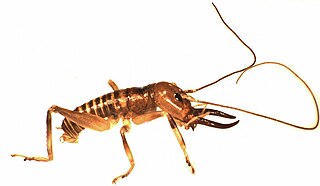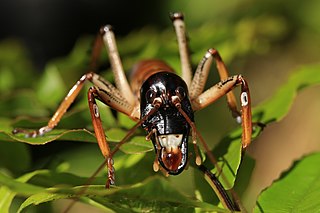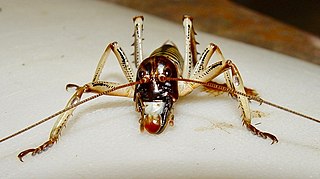
The orthopteran family Rhaphidophoridae of the suborder Ensifera has a worldwide distribution. Common names for these insects include the cave wētā, cave crickets, camelback crickets, camel crickets, Hogan bugs,spider crickets and sand treaders. Those occurring in New Zealand, Australia, and Tasmania are typically referred to as jumping or cave wētā. Most are found in forest environments or within caves, animal burrows, cellars, under stones, or in wood or similar environments. All species are flightless and nocturnal, usually with long antennae and legs. More than 1100 species of Rhaphidophoridae are described.

Hemiandrus is a genus of wētā in the family Anostostomatidae. In New Zealand they are known as ground wētā due to their burrowing lifestyle. Hemiandrus wētā are nocturnal, and reside in these burrows during the day. Ground wētā seal the entrance of their burrow during the day with a soil plug or door so that their burrow is concealed. This genus was originally said to be distributed in Australia and New Zealand, however, with recent molecular genetic methods, this is under debate. Ground wētā adults are smaller than other types of wētā, with the unusual trait of having both long and short ovipositors, depending on the species. The name of this genus is said to come from this trait as hemi- mean half and -andrus means male, as the species where the female has a short ovipositor can sometimes be mistaken for a male. This genus has a diverse diet, depending on the species.

The Northland tusked wētā, Anisoura nicobarica, is a rare monotypic wētā of the family Anostostomatidae, endemic to the northern half of Northland in New Zealand, and originally described in 1932. The type specimen was wrongly labelled as coming from the Nicobar Islands, so the species was named Anisoura nicobarica. It was erroneously described again in 1950 by a different author, who placed it in the ground wētā genus Hemiandrus.

Pachyrhamma is a genus of cave weta in the family Rhaphidophoridae, endemic to New Zealand.

Isoplectron is a genus of cave wētā in the family Rhaphidophoridae with three species currently recognized. The genus is endemic to New Zealand and distributed throughout the country.

Pharmacus is a genus of cave wētā in the family Rhaphidophoridae, endemic to New Zealand. All species are alpine adapted and found at high elevations in the South Island. They live among rocks on high mountain ridges, often well above glaciers and vegetation. Pharmacus has a geographical range that extends from Nelson south to central Otago and Fiordland. They are small insects with a body length of approximately 14-20mm. In this genus, females are larger than males. All species exhibit dark brown to black pigmentation of the body and legs. They have a dense clothing of setae and a serrated ovipositor. When active they are lively jumpers. For example, Pharmacus montanus is known as the Mount Cook flea because of its habit of leaping out of rock crevices on to mountain climbers.

Pleioplectron is a genus of cave wētā in the family Rhaphidophoridae, endemic to New Zealand. These wētā are fairly common at night among the leaf litter in native forest in the South Island of New Zealand. The species look very similar to species of Miotopus, another New Zealand endemic genus, recently resurrected.

Deinacrida fallai or the Poor Knights giant wētā is a species of insect in the family Anostostomatidae. It is endemic to the Poor Knights Islands off northern New Zealand. D. fallai are commonly called giant wētā due to their large size. They are one of the largest insects in the world, with a body length measuring up to 73 mm. Their size is an example of island gigantism. They are classified as vulnerable by the IUCN due to their restricted distribution.

Hemideina thoracica, commonly known as the Auckland tree wētā or tokoriro is a cricket-like insect. It is endemic to New Zealand and is found over most of the North Island, except for the Wellington region and regions 900 metres above sea level. This species is an arboreal, herbivorous generalist however, it is also thought to be polyphagous and is found in all wooded habitats, including forest, scrub and suburban gardens.

Pachyrhamma waitomoensis, known as the Waitomo cave weta, is a large species of cave weta, native to the Waitomo district of New Zealand.

Hemideina crassidens, commonly known as the Wellington tree wētā, is a large, flightless, nocturnal insect in the family Anostostomatidae. This wētā species is endemic to New Zealand and populates regions in the southern half of North Island/Te Ika a Maui and the north-west of the South Island/Te Wai Pounamu. They forage arboreally during the night and are most likely polyphagous. There is obvious sexual dimorphism in adults. Individuals are reliant on tree cavities for refuge, social interactions and mating.

Pachyrhamma acanthoceras, also known as the Auckland cave wētā, is a large species of cave wētā endemic to New Zealand.

Hemiandrus nox, the night ground wētā, is a species of ground wētā endemic to New Zealand. During the day, this wētā hides in burrows in the soil and is active only at night. The species is found in native forests in North and South Island. Females of this species have medium-long curved ovipositers to lay their eggs in the soil. Unlike some Hemiandrus species, H. nox does not show maternal care.

The Hawkes Bay tree wētā, Hemideina trewicki, is a large arboreal long-horned cricket in the order Orthoptera. The species is endemic to New Zealand and restricted to the Hawke's Bay region of North Island

Mary Morgan-Richards is a New Zealand biologist, and as of 2019 is a full professor at the Massey University.

Pachyrhamma edwardsii is a species of wētā, in the family Rhaphidophoridae, endemic to New Zealand. This species is found in caves, or large cavities where there is high humidity and little plant or animal life.

Wētā is the common name for a group of about 100 insect species in the families Anostostomatidae and Rhaphidophoridae endemic to New Zealand. They are giant flightless crickets, and some are among the heaviest insects in the world. Generally nocturnal, most small species are carnivores and scavengers while the larger species are herbivorous. Wētā are preyed on by introduced mammals, and some species are now critically endangered.

Hemiandrus focalis is a species of ground wētā endemic to New Zealand. This flightless Orthoptera lives in the mountains of the South Island, New Zealand. This species can be distinguished from other ground wētā by their three superior retrolateral spines on their mid tibia and females have relatively long ovipositors. This omnivorous ground wētā species is listed as "not threatened" by the New Zealand Department of Conservation.

Talitropsis sedilloti is a species of flightless wētā, in the family Rhaphidophoridae, endemic to Aotearoa New Zealand. This species is common in forests throughout New Zealand and during the day can be found hiding in holes in tree branches.
Aola Mary Richards was a New Zealand entomologist specialising in the study of New Zealand cave crickets (Rhaphidophoridae) and Australian ladybird beetles (Coccinellidae).




















